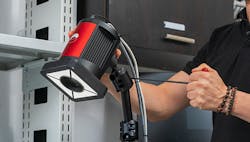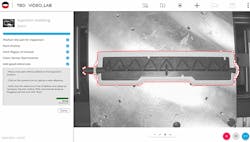Quality assurance (QA) is a critical component of a successful production strategy. However, the quality inspection of products made from plastics poses two main problems—the reflectiveness of materials and the presence of different products on the same production line. One option for overcoming these challenges is autonomous machine vision.
The costs of defective parts are notorious — rework or repair, material waste, warranty claims, erosion of customer trust and poor brand reputation are just some of the most obvious. In Industry 4.0, manufacturers strive to automate every possible step of production to reduce lead times, minimize costs and increase efficiency, but if the end product is low-quality, all efforts to optimize productivity are in vain. This is why a QA safety net is an essential aspect for all production or assembly lines.
Machine-vision solutions are the backbone of QA and are commonly used to inspect the results of plastic processing methods, including injection molding, rotational molding, extrusion, compression and 3D printing.
Plastics manufacturers must deal with specific hurdles in their sectors. The first is that the highly reflective surface of some plastics is hard to illuminate correctly, since light reflections can create visual disruption that is seen by cameras as a physical feature of the product. The second is that a plastic-injection-molding production line can make products that come in varying shapes and forms. Many plastics manufacturers fall back on manual quality checks.
Autonomous machine vision
These hurdles can be overcome with autonomous machine vision (AMV), a category developed in 2018. This technology uses AI at every step of the inspection process to offer systems that are completely autonomous, from self-adjusting their camera settings to autonomously determining how many sample items they need to check in order to learn the characteristics of a product. AMV powers end-to-end devices integrating software and hardware for optimal autonomous visual inspection that can be installed and moved to a different location if needed.
AMV systems are off-the-shelf products that can be set up in a short time, without any previous expertise in machine vision (Figure 1). The user can simply unbox the product, trace the outline of the item to inspect with a regular mouse, present 20 to 30 good sample items to the system and start inspecting. The same process can be repeated any time the manufacturer wants to inspect a new product, which makes AMV ideal for production lines that are frequently reconfigured.
AMV also opens the doors of accurate, reliable and cost-effective QA to small and medium businesses (SMBs).
Figure 2: In plastic injection molding, a good level of contrast in the image is also required to distinguish reliably between the product and the mold, which might be the same or very similar colors.
Correct illumination
To detect defects reliably by taking clear and informative pictures, machine-vision technology must be able to illuminate the object correctly. However, plastics present specific challenges. For example, some plastics, such as acrylonitrile-butadiene-styrene (ABS), has a glossy texture that creates a lot of reflection.
In plastic injection molding, a good level of contrast in the image is also required to distinguish reliably between the product and the mold, which might be the same or very similar colors (Figure 2). Challenges can occur when two similar colors appear the same due to insufficient illumination of the inside of the mold. Additionally, molding machines are built to be as compact as possible, opening just enough to eject the part but not enough to guarantee adequate illumination for automated QA. The worst-case scenario is when both the product and the background are black, which makes inspection extremely challenging.
With AMV, these challenges can be overcome, thanks to an AI module that dynamically adapts the electro-optics components of the machine-vision system. The user therefore does not need to specify the parameters for image capturing, such as the distance between the camera and the sample item, lighting, focus value, shutter speed and exposure time — all of this will be automatically selected and adjusted by the smart AI-based engine. AMV solutions can therefore automatically acquire the best image possible of the item to be inspected.
Moreover, the ability to automatically control the depth of field and run several profiles focusing on multiple areas of an object with different depths, means that AMV systems can work on deep and complex objects, effectively allowing defect inspection for complex 3D objects with a simple 2D camera.
Objects can also be photographed with different light directions and intensities, and the multiple photographs will be automatically combined to create a single reflectionless HDR image. This allows for a reliable inspection of reflective surfaces and overcomes challenges linked to the similarity in color between objects and their backgrounds.
Multi-product inspection
AMV allows manufacturers to inspect a variety of items with one single system. Plastics manufacturers can inspect any number of products—even tens or hundreds of different products — at that same location on the line. All they have to do is repeat an installation process when they need to inspect a new product.
This makes the technology particularly useful for manufacturers that have frequent production line changeovers or need to inspect customized batches of products. It is also a huge advantage for manufacturers that deploy 3D printing lines, which usually imply flexible production with small to medium volumes.
These benefits mean that plastics manufacturers now have access to reliable automated quality assurance, with systems that they can set up and operate themselves.
Yonatan Hyatt is CTO of Inspekto. Contact him at [email protected].
About the Author
Yonatan Hyatt
Inspekto

Leaders relevant to this article:


